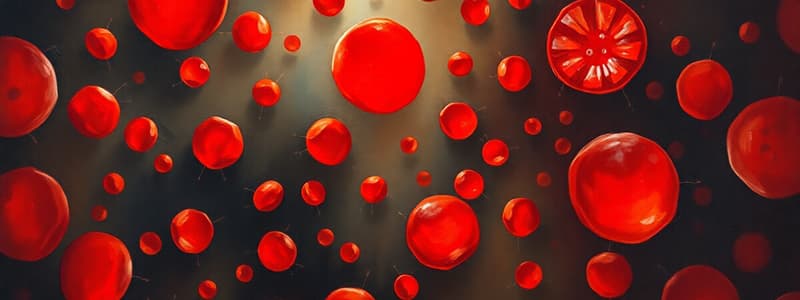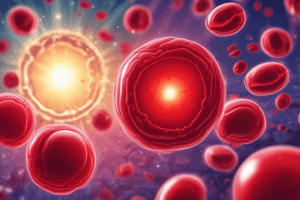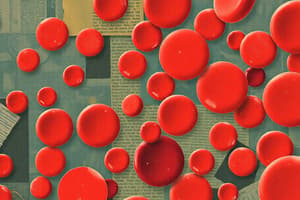Podcast
Questions and Answers
What characteristic appearance does amyloid present under light microscopy when stained with Congo red?
What characteristic appearance does amyloid present under light microscopy when stained with Congo red?
- Bright blue material
- Homogenous pink to orange-red material (correct)
- Granular yellow material
- Violet speckled material
Which feature is a hallmark diagnostic characteristic of amyloidosis when viewing deposits under polarized light?
Which feature is a hallmark diagnostic characteristic of amyloidosis when viewing deposits under polarized light?
- Red speckling
- Yellow birefringence
- Blue luminosity
- Apple-green birefringence (correct)
What is a prominent microscopic feature of malignant endothelial cells in Kaposi's Sarcoma?
What is a prominent microscopic feature of malignant endothelial cells in Kaposi's Sarcoma?
- Prominent central necrosis
- Spindle-shaped and disturbed appearance (correct)
- Large multinucleated giant cells
- High mitotic index with uniform morphology
Which condition is primarily associated with the deposition of misfolded serum amyloid A proteins?
Which condition is primarily associated with the deposition of misfolded serum amyloid A proteins?
What causes extravasation of red blood cells in the context of Kaposi's Sarcoma?
What causes extravasation of red blood cells in the context of Kaposi's Sarcoma?
Which feature is commonly associated with Hashimoto's thyroiditis due to chronic inflammation?
Which feature is commonly associated with Hashimoto's thyroiditis due to chronic inflammation?
What is a hallmark characteristic of lymphoid germinal centers in Hashimoto's thyroiditis?
What is a hallmark characteristic of lymphoid germinal centers in Hashimoto's thyroiditis?
What does Congo red staining primarily detect in tissues affected by amyloidosis?
What does Congo red staining primarily detect in tissues affected by amyloidosis?
Which of the following is not a typical microscopic feature of Hashimoto's thyroiditis?
Which of the following is not a typical microscopic feature of Hashimoto's thyroiditis?
What does the fibrotic process in Hashimoto's thyroiditis contribute to in terms of thyroid gland characteristics?
What does the fibrotic process in Hashimoto's thyroiditis contribute to in terms of thyroid gland characteristics?
Flashcards
Amyloid deposition in vessels
Amyloid deposition in vessels
Amyloid proteins accumulate in blood vessel walls, weakening them and potentially disrupting blood flow.
Congo Red stain
Congo Red stain
A stain that specifically binds to amyloid fibrils, allowing them to be visualized under a microscope.
Apple-green birefringence
Apple-green birefringence
A characteristic optical property of amyloid deposits seen under polarized light (a change in color when looked at through a special filter).
Kaposi's sarcoma
Kaposi's sarcoma
Signup and view all the flashcards
Extravasated red blood cells (RBCs)
Extravasated red blood cells (RBCs)
Signup and view all the flashcards
Hurthle Cells
Hurthle Cells
Signup and view all the flashcards
Fibrosis in Hashimoto's Thyroiditis
Fibrosis in Hashimoto's Thyroiditis
Signup and view all the flashcards
Lymphoid Germinal Centers in Hashimoto's
Lymphoid Germinal Centers in Hashimoto's
Signup and view all the flashcards
Destruction of Follicular Cells
Destruction of Follicular Cells
Signup and view all the flashcards
Amyloid Deposits in Blood Vessels
Amyloid Deposits in Blood Vessels
Signup and view all the flashcards
Study Notes
Hemolytic Anemia
- A condition where red blood cells (RBCs) are destroyed faster than they can be produced.
- Associated with Type II hypersensitivity (antibody-mediated hypersensitivity).
- Microscopy shows a "chewed-up" appearance of RBCs, with fragmented or abnormally shaped cells like schistocytes (fragmented RBCs) and spherocytes (spherical RBCs).
- These features are hallmarks of hemolysis.
Key Features of Hemolytic Anemia
- Chewed-Up Appearance of Red Cells:
- RBCs are prematurely destroyed due to factors like autoimmune processes, mechanical damage, or abnormal red cell membranes.
- Odd-Shaped and Fragmented Cells:
- Red blood cells are damaged while traveling through the blood vessels or attacked by the immune system.
- This is a critical diagnostic feature in conditions like microangiopathic hemolytic anemia, where RBCs are sheared.
- Target Cells:
- Red blood cells with a bullseye appearance.
- Can be seen in various conditions like hemolytic anemias, liver disease, or certain hemoglobinopathies.
- Presence of Reticulocytes:
- Immature red blood cells released from the bone marrow.
- The percentage of reticulocytes usually increases to compensate for the rapid destruction of red cells in hemolytic anemia
Hashimoto's Thyroiditis
- Associated with Type IV hypersensitivity (delayed-type hypersensitivity) and involves a combination of cell-mediated immunity and autoantibody production (Type II hypersensitivity may also contribute).
- Microscopic Features:
- Lymphoid Aggregates: Dense clusters of lymphocytes (both B-cells and T-cells) infiltrate the thyroid gland. These aggregates often form germinal centers, where B-cells mature and differentiate.
- Destruction of Follicular Cells: Thyroid follicular cells are destroyed and replaced by inflammatory cells. Some areas may show atrophic follicles with pink-staining colloid.
- Hurthle Cell Metaplasia: Thyroid follicular cells transform into Hurthle cells (enlarged cells with abundant, eosinophilic cytoplasm) due to chronic injury and inflammation.
- Fibrosis: Fibrosis replaces the normal thyroid architecture, giving a lobulated appearance. This contributes to the thyroid gland's firmness on palpation.
- Atrophic Follicles: The normal glandular tissue is significantly reduced or absent in areas of advanced disease.
- Chronic Inflammatory Infiltrate: Hashimoto's thyroiditis is characterized by the infiltration of lymphocytes, plasma cells, and other immune cells. These inflammatory cells lead to destruction of the normal thyroid architecture.
- Lymphoid Germinal Centers: Active germinal centers are a hallmark of Hashimoto's thyroiditis. These centers form within the thyroid tissue itself, where B-cells proliferate and mature, indicating an autoimmune process.
- Destruction of the Gland: Extensive damage to thyroid follicles is observed, leading to a decrease in functional thyroid tissue over time.
- Hurthle Cells: In areas attempting regeneration, Hurthle cells appear. These are large, eosinophilic cells with abundant, granular cytoplasm. They result from follicular cell transformation due to chronic inflammation
Skin with Amyloidosis
- Amyloidosis is a condition characterized by the extracellular deposition of misfolded proteins, forming insoluble fibrils known as amyloid.
- These deposits disrupt normal tissue architecture and function.
- Congo Red Staining:
- Congo red is a special stain used to detect amyloid.
- The dye binds specifically to the β-pleated sheet structure of amyloid fibrils. Microscopy shows the deposits as homogenous pink to orange-red material.
- Under polarized light, amyloid deposits show an apple-green birefringence - a hallmark of amyloidosis.
Vascular Amyloid Deposits
- Within the dermis, amyloid accumulates primarily in the walls of blood vessels.
- This deposition weakens the vessel walls and may impair normal blood flow.
Kaposi's Sarcoma
- A vascular tumor arising from endothelial cells, associated with Human Herpesvirus-8 (HHV-8) infection.
- Commonly affects the skin, but can involve mucous membranes, lymph nodes, and visceral organs.
- Microscopic Features:
- Malignant Endothelial Cells: observation of spindle-shaped and distorted-looking endothelial cells, sometimes resembling fibroblasts in appearance.
- Irregular Vascular Structures: Endothelial cells form irregular vascular structures, a hallmark of Kaposi's sarcoma.
- Diagnostic Clues: Atypical features such as nuclear pleomorphism, hyperchromasia, and abnormal mitoses are observed.
- Extravasated Red Blood Cells: Red blood cells are present outside of blood vessels in the connective tissue, due to leakage from the abnormal vascular channels.
- Hemosiderin Deposits: Evidence of prior RBC degradation within the background connective tissue, or histiocytes.
- Inflammatory Infiltrate: Mixed inflammatory cells like lymphocytes, plasma cells, and macrophages are often present.
- Characteristic Vascular Slits: Irregular, slit-like spaces filled with red blood cells are a key diagnostic feature, reflecting abnormal angiogenesis driven by malignant endothelial cells.
- Malignant Cells Lining Abnormal Vascular Spaces: Malignant cells line the abnormal blood vessels.
Histological features of Kaposi's Sarcoma
- Spindle Cells: Malignant endothelial cells
- Slit-like vascular spaces: Poorly formed vascular channels containing RBC's
- Hemosiderin deposits: Evidence of prior RBC degradation
- Inflammatory infiltrate: Lymphocytes, plasma cells, and macrophages are commonly present
- HHV-8 positivity: Confirmatory with immunohistochemical staining.
Studying That Suits You
Use AI to generate personalized quizzes and flashcards to suit your learning preferences.




